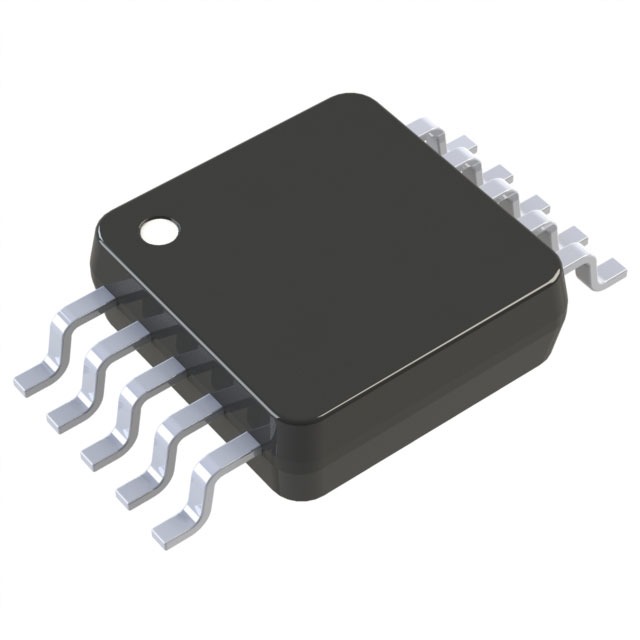CAT24C16ZI-GT3
Product Overview
Category
The CAT24C16ZI-GT3 belongs to the category of electrically erasable programmable read-only memory (EEPROM) chips.
Use
This chip is commonly used for non-volatile data storage in various electronic devices, such as microcontrollers, computers, and consumer electronics.
Characteristics
- Non-volatile: The CAT24C16ZI-GT3 retains stored data even when power is removed.
- High density: It has a storage capacity of 16 kilobits (2 kilobytes).
- Low power consumption: The chip operates at low voltage levels, making it energy-efficient.
- Fast write and read speeds: It offers quick data transfer rates, enhancing overall device performance.
Package
The CAT24C16ZI-GT3 comes in an industry-standard 8-pin SOIC (Small Outline Integrated Circuit) package.
Essence
This EEPROM chip allows for reliable and efficient data storage, retrieval, and modification in electronic systems.
Packaging/Quantity
The CAT24C16ZI-GT3 is typically packaged in reels or tubes, with each containing a specific quantity of chips. The exact packaging and quantity may vary depending on the manufacturer's specifications.
Specifications
- Memory capacity: 16 kilobits (2 kilobytes)
- Interface: I2C (Inter-Integrated Circuit)
- Supply voltage: 1.7V to 5.5V
- Operating temperature range: -40°C to +85°C
- Write endurance: 1 million cycles
- Data retention: 100 years
Detailed Pin Configuration
The CAT24C16ZI-GT3 features the following pin configuration:
- A0: Address input bit 0
- A1: Address input bit 1
- A2: Address input bit 2
- GND: Ground
- SDA: Serial data input/output
- SCL: Serial clock input
- WP: Write protect
- VCC: Supply voltage
Functional Features
- Random access: Allows for reading and writing data at any memory location.
- Byte-level operations: Supports individual byte read and write operations.
- Hardware write protection: The WP pin can be used to prevent accidental writes.
- Sequential read mode: Enables efficient consecutive data retrieval.
Advantages and Disadvantages
Advantages
- Non-volatile storage ensures data integrity even during power loss.
- High-density memory capacity meets the requirements of various applications.
- Low power consumption prolongs battery life in portable devices.
- Fast write and read speeds enhance overall system performance.
Disadvantages
- Limited storage capacity compared to other memory technologies.
- Relatively higher cost per kilobit compared to larger EEPROM chips.
- Requires an I2C interface, which may not be compatible with all systems.
Working Principles
The CAT24C16ZI-GT3 utilizes electrically controlled floating gate transistors to store and retrieve data. When writing data, a high voltage is applied to the gate, allowing electrons to tunnel through a thin oxide layer and become trapped in the floating gate. This trapped charge represents a binary value (0 or 1). During read operations, the stored charge is sensed, and the corresponding data is retrieved.
Detailed Application Field Plans
The CAT24C16ZI-GT3 finds application in various fields, including:
- Embedded systems: Used for storing configuration data, firmware updates, and calibration parameters in microcontrollers.
- Automotive electronics: Employed for storing critical data like vehicle identification numbers (VIN), mileage, and user preferences.
- Industrial automation: Utilized for storing machine settings, production data, and user-specific configurations.
- Consumer electronics: Integrated into devices like smart TVs, set-top boxes, and audio systems for storing user preferences and settings.
Detailed and Complete Alternative Models
- CAT24C02WI-GT3: 2 kilobit (256 byte) EEPROM chip with similar characteristics and package.
- CAT24C32WI-GT3: 32 kilobit (4 kilobyte) EEPROM chip with higher storage capacity.
- CAT24C64WI-GT3: 64 kilobit (8 kilobyte) EEPROM chip with even greater storage capacity.
These alternative models offer varying memory capacities to suit different application requirements while maintaining similar functionality and characteristics.
Word count: 570 words
قم بإدراج 10 أسئلة وإجابات شائعة تتعلق بتطبيق CAT24C16ZI-GT3 في الحلول التقنية
Sure! Here are 10 common questions and answers related to the application of CAT24C16ZI-GT3 in technical solutions:
Q: What is CAT24C16ZI-GT3? A: CAT24C16ZI-GT3 is a 16K-bit I2C Serial EEPROM (Electrically Erasable Programmable Read-Only Memory) manufactured by ON Semiconductor.
Q: What is the operating voltage range for CAT24C16ZI-GT3? A: The operating voltage range for CAT24C16ZI-GT3 is typically between 1.7V and 5.5V.
Q: What is the storage capacity of CAT24C16ZI-GT3? A: CAT24C16ZI-GT3 has a storage capacity of 16 kilobits, which is equivalent to 2 kilobytes.
Q: What is the communication protocol used by CAT24C16ZI-GT3? A: CAT24C16ZI-GT3 uses the I2C (Inter-Integrated Circuit) communication protocol for data transfer.
Q: Can CAT24C16ZI-GT3 be used in automotive applications? A: Yes, CAT24C16ZI-GT3 is designed to meet the requirements of automotive applications and is qualified according to AEC-Q100 standards.
Q: What is the maximum clock frequency supported by CAT24C16ZI-GT3? A: CAT24C16ZI-GT3 supports a maximum clock frequency of 400 kHz.
Q: Does CAT24C16ZI-GT3 have built-in write protection? A: Yes, CAT24C16ZI-GT3 features a built-in write protection mechanism that allows you to protect specific memory locations from being overwritten.
Q: Can CAT24C16ZI-GT3 operate in a wide temperature range? A: Yes, CAT24C16ZI-GT3 is designed to operate in a wide temperature range, typically from -40°C to +125°C.
Q: Is CAT24C16ZI-GT3 compatible with 5V systems? A: Yes, CAT24C16ZI-GT3 is fully compatible with both 3.3V and 5V systems.
Q: What are some typical applications of CAT24C16ZI-GT3? A: CAT24C16ZI-GT3 is commonly used in various technical solutions such as industrial automation, consumer electronics, automotive systems, medical devices, and more for data storage and configuration purposes.
Please note that the answers provided here are general and may vary depending on the specific requirements and use cases.


